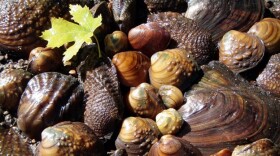No matter what your food preferences – whether you are a vegan, vegetarian or omnivore – plants are at the base of what you eat. Okay, you say, but what about Oreos, one of my major food groups? Surely, they are mostly a petroleum derivative? Leaving aside that petroleum is also originally plant material, let’s check out Oreos. I can’t get Nabisco’s secret recipe, but I found a substitute online so we can make our own. And, no big surprise, plants are critical to every bit of this recipe.
For the cookie we will need flour, sugar, vanilla, cocoa, butter and salt. Where does all this come from?
The flour, of course, is wheat (or some other grain substitute from my gluten-free friends). Wheat is in the grass family, or Poaceae, like other familiar grasses we eat such as rye, barley and even wild rice. They all have a similar flower structure, which is how plants are grouped into families and genera. The most widely grown wheat is Triticum aestivum. Like most grasses, wheat plants produce small, wind pollinated flowers. Once fertilized, each flower produces a small fruit, with seeds called wheat berries inside. The fruits are harvested and threshed to remove the chaff. The outer coating of the wheat berry, the bran, is usually removed and the grains are then ground into flour. Wheat flour is mostly starch, with some protein and other nutrients.
Our next ingredient is sugar. Sugar comes from a couple of different plants. Most commercial sugar comes from sugar beets, or Beta vulgaris in the Amaranthaceae or sugar cane, a grass in the Saccharum genus. Of course, corn syrup comes from corn, or Zea mays, yet another grass. The sugar we will use in our recipe is sucrose, a compound sugar composed of the simple sugars fructose and glucose bonded together. Simple and compound sugars are sweet and easily dissolved in water. Longer chains of sugar molecules compose polysaccharides, including starch, as in the flour. Unlike the flour, sugar has few redeeming qualities and provides nothing but calories (and tasty sweetness).
Next comes butter. Butter comes from cows’ milk, and to produce the milk, cows eat mostly grasses such as blue stem and rye but also some legumes such as alfalfa and clover.
The salt? Okay, I admit the salt doesn’t come from a plant.
Cocoa is next. Oreos famously have a very rich chocolate flavor, and you know the instant you bite into a cookie if it is the real thing, or an imitation just based on the depth of the chocolate flavor. Chocolate comes from the cacao tree, Theobroma cacao. Carl Linnaeus named the tree “Theobroma” or “food of the gods” (and I agree with Carl on the heavenly origin of chocolate). The cacao is a small tree native to the Amazon Forest, but most of the commercially grown cacao grows in west Africa within 20 degrees of the equator. The seeds are inside a large pulpy pod that juts right out of the tree trunk. The cacao seeds are extracted from the pod and the seeds are then fermented, dried, and roasted. The seeds are ground into small nibs, and, if the cocoa butter is removed the remainder is then pulverized to make cocoa powder.
We now need vanilla. Vanilla comes from the vanilla orchid, a tropical vine native to Mexico, but now mostly grown in Madagascar. We usually see vanilla as a liquid, but it comes at the end of a long, delicate process. The natural pollinator of the vanilla orchid is the tiny Melipona bee, but because this tiny insect lives only in Mexico, nearly all vanilla flowers are hand pollinated. Once fertilized, the vanilla fruit, often called a bean because of its skinny bean-like shape, starts to grow. The “bean” must ripen on the vine; it will not ripen once picked. After picking, the beans are briefly plunged into hot water to develop the enzymes that create the vanilla flavor. The beans are slowly dried to fully develop the flavor and then are ready for shipping. I watched a YouTube video where they put mail-ordered vanilla beans into a bottle of vodka, and then explained they had to wait a year before the liquor would be ready. This brown infusion is what we add to cookies and cakes.
Isn’t it amazing that humanity worked all this out? Especially the chocolate and the vanilla – how did they ever figure out how to unlock these flavors? And the importance of grasses is wild – from wheat to sugar cane, to corn to fodder for cows. I will leave it to you to find a recipe for Oreos online, or you might want to run to the store for that iconic blue package.









